Internal Reporting, Costing Systems, and Variance Analysis at M&S
VerifiedAdded on 2020/10/05
|18
|3247
|253
Report
AI Summary
This report provides a comprehensive analysis of costs and revenues, focusing on the case of Marks and Spencer (M&S). It begins with an introduction to revenue, cost of goods sold, and their relationship, setting the stage for an examination of M&S's internal reporting practices. The report delves into the purpose of internal reporting, the relationship between different costing systems (job, process, and activity-based costing), and the roles of responsibility, cost, profit, and investment centers within a firm. It then explores various cost classifications (fixed, variable, marginal, and distribution channel costs) and their applications. The report includes detailed cost information recording and analysis, covering material, labor, and expenses, and the different stages of inventory (raw materials, work-in-progress, and finished goods). It also examines overhead cost allocation and absorption rates, variance analysis, and the preparation of management reports. The report also covers the impact of changing activity levels on unit costs and factors influencing short and long-term decision-making. The report concludes with a summary of findings and references used.
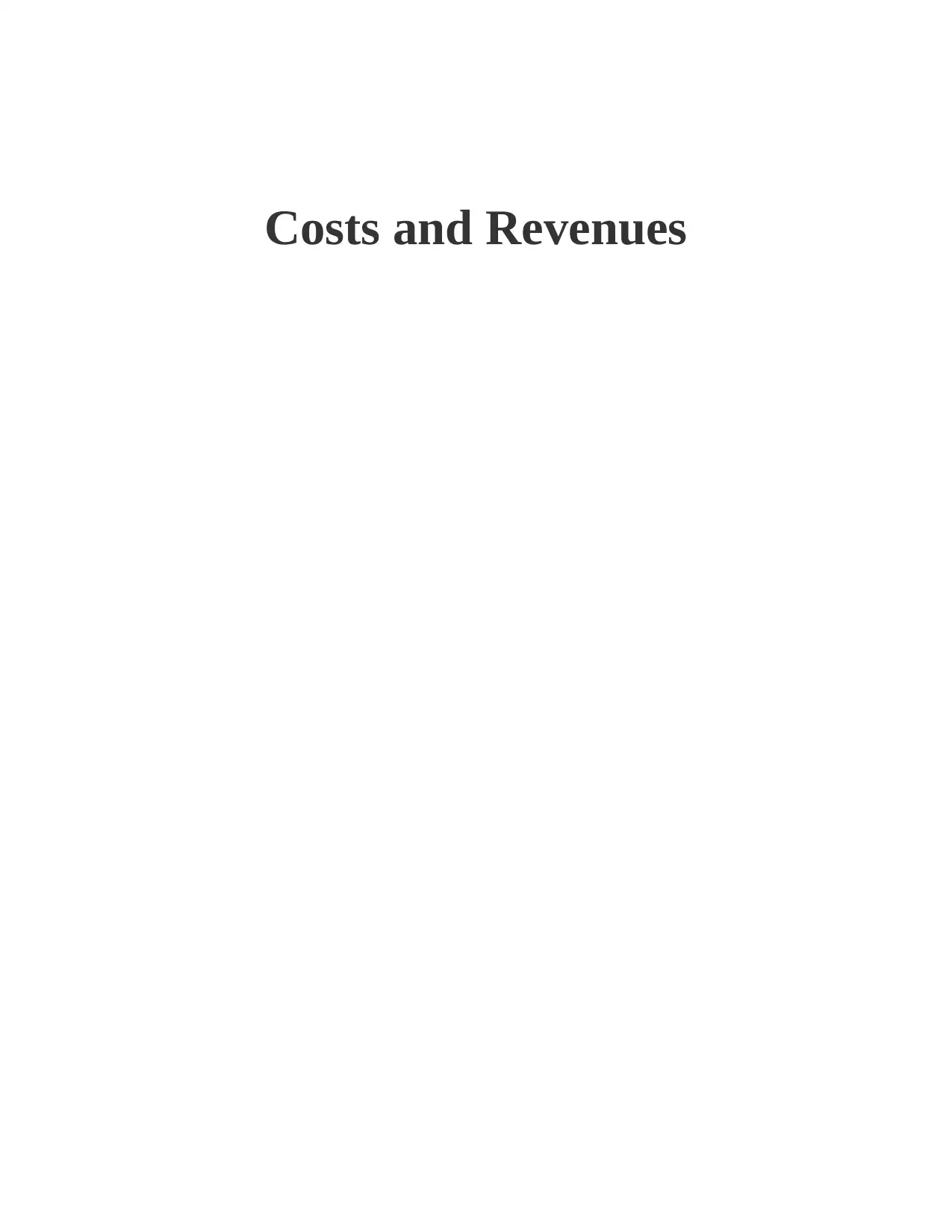
Costs and Revenues
Paraphrase This Document
Need a fresh take? Get an instant paraphrase of this document with our AI Paraphraser
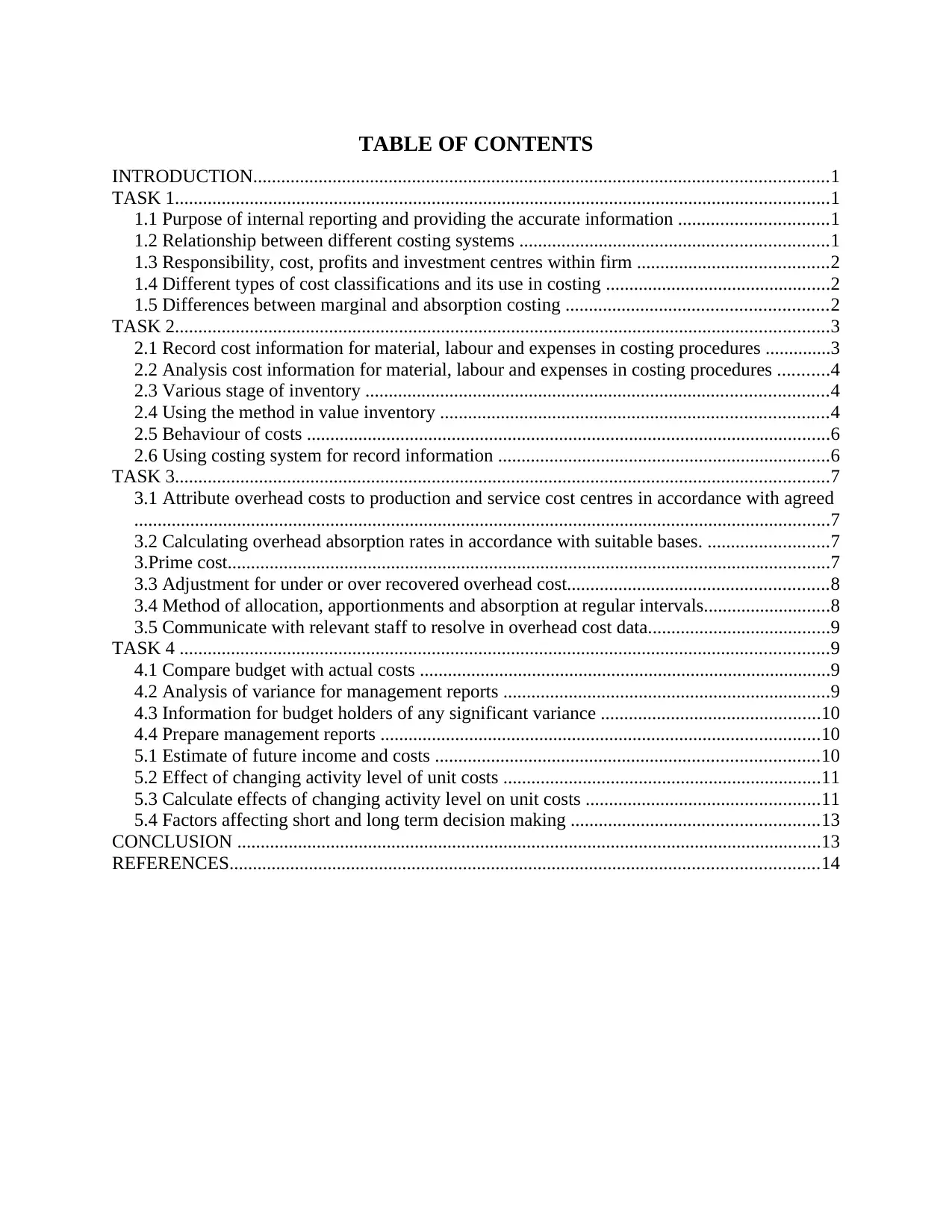
TABLE OF CONTENTS
INTRODUCTION...........................................................................................................................1
TASK 1............................................................................................................................................1
1.1 Purpose of internal reporting and providing the accurate information ................................1
1.2 Relationship between different costing systems ..................................................................1
1.3 Responsibility, cost, profits and investment centres within firm .........................................2
1.4 Different types of cost classifications and its use in costing ................................................2
1.5 Differences between marginal and absorption costing ........................................................2
TASK 2............................................................................................................................................3
2.1 Record cost information for material, labour and expenses in costing procedures ..............3
2.2 Analysis cost information for material, labour and expenses in costing procedures ...........4
2.3 Various stage of inventory ...................................................................................................4
2.4 Using the method in value inventory ...................................................................................4
2.5 Behaviour of costs ................................................................................................................6
2.6 Using costing system for record information .......................................................................6
TASK 3............................................................................................................................................7
3.1 Attribute overhead costs to production and service cost centres in accordance with agreed
.....................................................................................................................................................7
3.2 Calculating overhead absorption rates in accordance with suitable bases. ..........................7
3.Prime cost.................................................................................................................................7
3.3 Adjustment for under or over recovered overhead cost........................................................8
3.4 Method of allocation, apportionments and absorption at regular intervals...........................8
3.5 Communicate with relevant staff to resolve in overhead cost data.......................................9
TASK 4 ...........................................................................................................................................9
4.1 Compare budget with actual costs ........................................................................................9
4.2 Analysis of variance for management reports ......................................................................9
4.3 Information for budget holders of any significant variance ...............................................10
4.4 Prepare management reports ..............................................................................................10
5.1 Estimate of future income and costs ..................................................................................10
5.2 Effect of changing activity level of unit costs ....................................................................11
5.3 Calculate effects of changing activity level on unit costs ..................................................11
5.4 Factors affecting short and long term decision making .....................................................13
CONCLUSION .............................................................................................................................13
REFERENCES..............................................................................................................................14
INTRODUCTION...........................................................................................................................1
TASK 1............................................................................................................................................1
1.1 Purpose of internal reporting and providing the accurate information ................................1
1.2 Relationship between different costing systems ..................................................................1
1.3 Responsibility, cost, profits and investment centres within firm .........................................2
1.4 Different types of cost classifications and its use in costing ................................................2
1.5 Differences between marginal and absorption costing ........................................................2
TASK 2............................................................................................................................................3
2.1 Record cost information for material, labour and expenses in costing procedures ..............3
2.2 Analysis cost information for material, labour and expenses in costing procedures ...........4
2.3 Various stage of inventory ...................................................................................................4
2.4 Using the method in value inventory ...................................................................................4
2.5 Behaviour of costs ................................................................................................................6
2.6 Using costing system for record information .......................................................................6
TASK 3............................................................................................................................................7
3.1 Attribute overhead costs to production and service cost centres in accordance with agreed
.....................................................................................................................................................7
3.2 Calculating overhead absorption rates in accordance with suitable bases. ..........................7
3.Prime cost.................................................................................................................................7
3.3 Adjustment for under or over recovered overhead cost........................................................8
3.4 Method of allocation, apportionments and absorption at regular intervals...........................8
3.5 Communicate with relevant staff to resolve in overhead cost data.......................................9
TASK 4 ...........................................................................................................................................9
4.1 Compare budget with actual costs ........................................................................................9
4.2 Analysis of variance for management reports ......................................................................9
4.3 Information for budget holders of any significant variance ...............................................10
4.4 Prepare management reports ..............................................................................................10
5.1 Estimate of future income and costs ..................................................................................10
5.2 Effect of changing activity level of unit costs ....................................................................11
5.3 Calculate effects of changing activity level on unit costs ..................................................11
5.4 Factors affecting short and long term decision making .....................................................13
CONCLUSION .............................................................................................................................13
REFERENCES..............................................................................................................................14
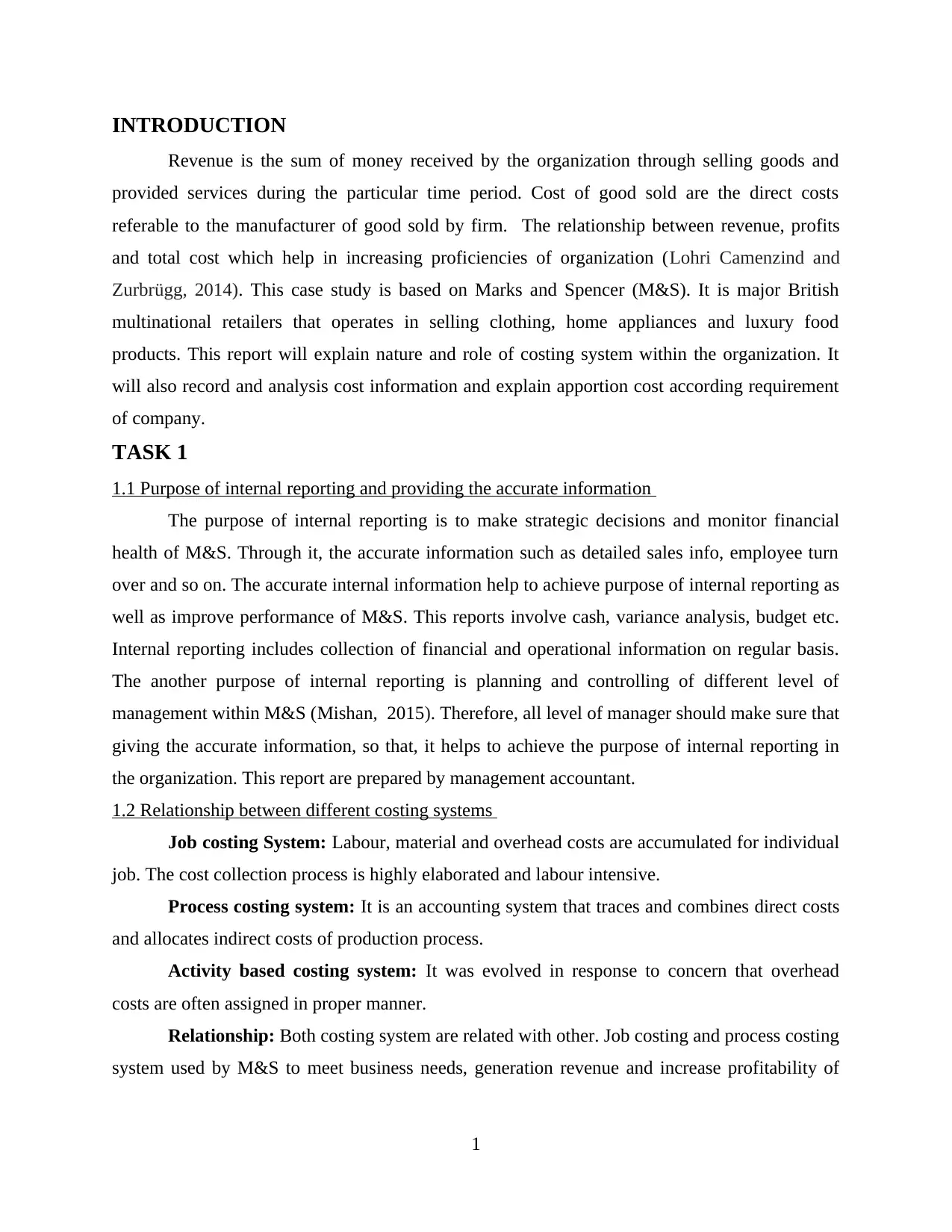
INTRODUCTION
Revenue is the sum of money received by the organization through selling goods and
provided services during the particular time period. Cost of good sold are the direct costs
referable to the manufacturer of good sold by firm. The relationship between revenue, profits
and total cost which help in increasing proficiencies of organization (Lohri Camenzind and
Zurbrügg, 2014). This case study is based on Marks and Spencer (M&S). It is major British
multinational retailers that operates in selling clothing, home appliances and luxury food
products. This report will explain nature and role of costing system within the organization. It
will also record and analysis cost information and explain apportion cost according requirement
of company.
TASK 1
1.1 Purpose of internal reporting and providing the accurate information
The purpose of internal reporting is to make strategic decisions and monitor financial
health of M&S. Through it, the accurate information such as detailed sales info, employee turn
over and so on. The accurate internal information help to achieve purpose of internal reporting as
well as improve performance of M&S. This reports involve cash, variance analysis, budget etc.
Internal reporting includes collection of financial and operational information on regular basis.
The another purpose of internal reporting is planning and controlling of different level of
management within M&S (Mishan, 2015). Therefore, all level of manager should make sure that
giving the accurate information, so that, it helps to achieve the purpose of internal reporting in
the organization. This report are prepared by management accountant.
1.2 Relationship between different costing systems
Job costing System: Labour, material and overhead costs are accumulated for individual
job. The cost collection process is highly elaborated and labour intensive.
Process costing system: It is an accounting system that traces and combines direct costs
and allocates indirect costs of production process.
Activity based costing system: It was evolved in response to concern that overhead
costs are often assigned in proper manner.
Relationship: Both costing system are related with other. Job costing and process costing
system used by M&S to meet business needs, generation revenue and increase profitability of
1
Revenue is the sum of money received by the organization through selling goods and
provided services during the particular time period. Cost of good sold are the direct costs
referable to the manufacturer of good sold by firm. The relationship between revenue, profits
and total cost which help in increasing proficiencies of organization (Lohri Camenzind and
Zurbrügg, 2014). This case study is based on Marks and Spencer (M&S). It is major British
multinational retailers that operates in selling clothing, home appliances and luxury food
products. This report will explain nature and role of costing system within the organization. It
will also record and analysis cost information and explain apportion cost according requirement
of company.
TASK 1
1.1 Purpose of internal reporting and providing the accurate information
The purpose of internal reporting is to make strategic decisions and monitor financial
health of M&S. Through it, the accurate information such as detailed sales info, employee turn
over and so on. The accurate internal information help to achieve purpose of internal reporting as
well as improve performance of M&S. This reports involve cash, variance analysis, budget etc.
Internal reporting includes collection of financial and operational information on regular basis.
The another purpose of internal reporting is planning and controlling of different level of
management within M&S (Mishan, 2015). Therefore, all level of manager should make sure that
giving the accurate information, so that, it helps to achieve the purpose of internal reporting in
the organization. This report are prepared by management accountant.
1.2 Relationship between different costing systems
Job costing System: Labour, material and overhead costs are accumulated for individual
job. The cost collection process is highly elaborated and labour intensive.
Process costing system: It is an accounting system that traces and combines direct costs
and allocates indirect costs of production process.
Activity based costing system: It was evolved in response to concern that overhead
costs are often assigned in proper manner.
Relationship: Both costing system are related with other. Job costing and process costing
system used by M&S to meet business needs, generation revenue and increase profitability of
1
⊘ This is a preview!⊘
Do you want full access?
Subscribe today to unlock all pages.

Trusted by 1+ million students worldwide
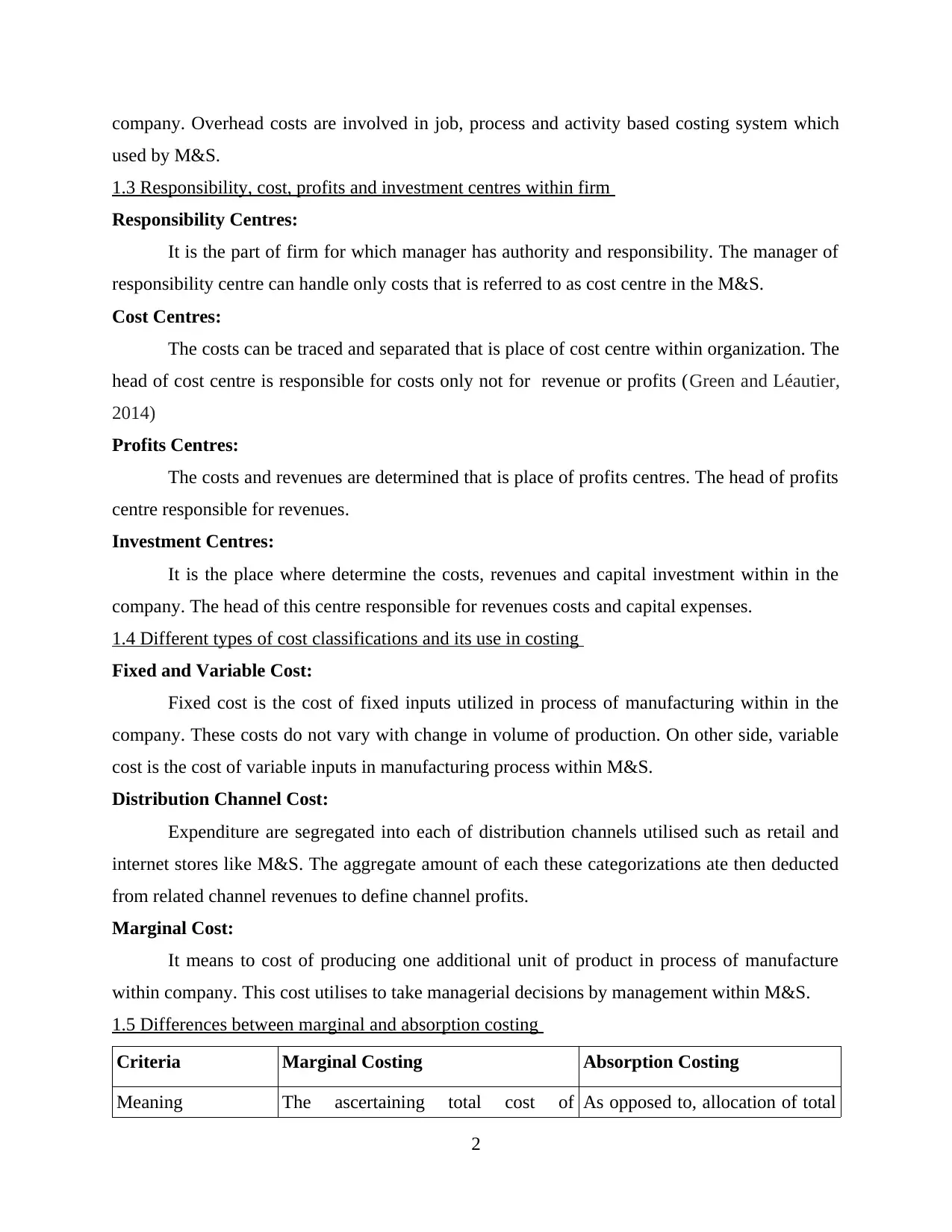
company. Overhead costs are involved in job, process and activity based costing system which
used by M&S.
1.3 Responsibility, cost, profits and investment centres within firm
Responsibility Centres:
It is the part of firm for which manager has authority and responsibility. The manager of
responsibility centre can handle only costs that is referred to as cost centre in the M&S.
Cost Centres:
The costs can be traced and separated that is place of cost centre within organization. The
head of cost centre is responsible for costs only not for revenue or profits (Green and Léautier,
2014)
Profits Centres:
The costs and revenues are determined that is place of profits centres. The head of profits
centre responsible for revenues.
Investment Centres:
It is the place where determine the costs, revenues and capital investment within in the
company. The head of this centre responsible for revenues costs and capital expenses.
1.4 Different types of cost classifications and its use in costing
Fixed and Variable Cost:
Fixed cost is the cost of fixed inputs utilized in process of manufacturing within in the
company. These costs do not vary with change in volume of production. On other side, variable
cost is the cost of variable inputs in manufacturing process within M&S.
Distribution Channel Cost:
Expenditure are segregated into each of distribution channels utilised such as retail and
internet stores like M&S. The aggregate amount of each these categorizations ate then deducted
from related channel revenues to define channel profits.
Marginal Cost:
It means to cost of producing one additional unit of product in process of manufacture
within company. This cost utilises to take managerial decisions by management within M&S.
1.5 Differences between marginal and absorption costing
Criteria Marginal Costing Absorption Costing
Meaning The ascertaining total cost of As opposed to, allocation of total
2
used by M&S.
1.3 Responsibility, cost, profits and investment centres within firm
Responsibility Centres:
It is the part of firm for which manager has authority and responsibility. The manager of
responsibility centre can handle only costs that is referred to as cost centre in the M&S.
Cost Centres:
The costs can be traced and separated that is place of cost centre within organization. The
head of cost centre is responsible for costs only not for revenue or profits (Green and Léautier,
2014)
Profits Centres:
The costs and revenues are determined that is place of profits centres. The head of profits
centre responsible for revenues.
Investment Centres:
It is the place where determine the costs, revenues and capital investment within in the
company. The head of this centre responsible for revenues costs and capital expenses.
1.4 Different types of cost classifications and its use in costing
Fixed and Variable Cost:
Fixed cost is the cost of fixed inputs utilized in process of manufacturing within in the
company. These costs do not vary with change in volume of production. On other side, variable
cost is the cost of variable inputs in manufacturing process within M&S.
Distribution Channel Cost:
Expenditure are segregated into each of distribution channels utilised such as retail and
internet stores like M&S. The aggregate amount of each these categorizations ate then deducted
from related channel revenues to define channel profits.
Marginal Cost:
It means to cost of producing one additional unit of product in process of manufacture
within company. This cost utilises to take managerial decisions by management within M&S.
1.5 Differences between marginal and absorption costing
Criteria Marginal Costing Absorption Costing
Meaning The ascertaining total cost of As opposed to, allocation of total
2
Paraphrase This Document
Need a fresh take? Get an instant paraphrase of this document with our AI Paraphraser
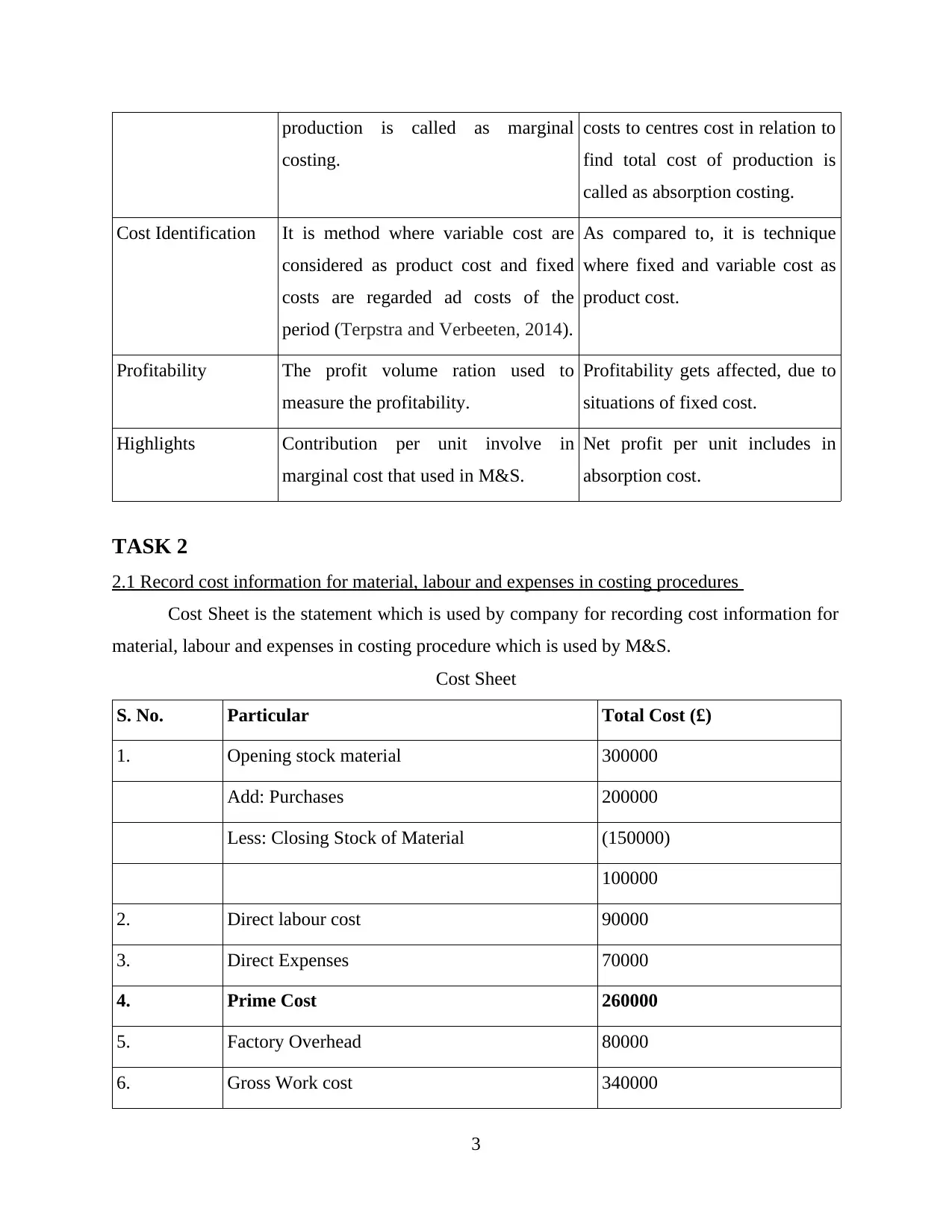
production is called as marginal
costing.
costs to centres cost in relation to
find total cost of production is
called as absorption costing.
Cost Identification It is method where variable cost are
considered as product cost and fixed
costs are regarded ad costs of the
period (Terpstra and Verbeeten, 2014).
As compared to, it is technique
where fixed and variable cost as
product cost.
Profitability The profit volume ration used to
measure the profitability.
Profitability gets affected, due to
situations of fixed cost.
Highlights Contribution per unit involve in
marginal cost that used in M&S.
Net profit per unit includes in
absorption cost.
TASK 2
2.1 Record cost information for material, labour and expenses in costing procedures
Cost Sheet is the statement which is used by company for recording cost information for
material, labour and expenses in costing procedure which is used by M&S.
Cost Sheet
S. No. Particular Total Cost (£)
1. Opening stock material 300000
Add: Purchases 200000
Less: Closing Stock of Material (150000)
100000
2. Direct labour cost 90000
3. Direct Expenses 70000
4. Prime Cost 260000
5. Factory Overhead 80000
6. Gross Work cost 340000
3
costing.
costs to centres cost in relation to
find total cost of production is
called as absorption costing.
Cost Identification It is method where variable cost are
considered as product cost and fixed
costs are regarded ad costs of the
period (Terpstra and Verbeeten, 2014).
As compared to, it is technique
where fixed and variable cost as
product cost.
Profitability The profit volume ration used to
measure the profitability.
Profitability gets affected, due to
situations of fixed cost.
Highlights Contribution per unit involve in
marginal cost that used in M&S.
Net profit per unit includes in
absorption cost.
TASK 2
2.1 Record cost information for material, labour and expenses in costing procedures
Cost Sheet is the statement which is used by company for recording cost information for
material, labour and expenses in costing procedure which is used by M&S.
Cost Sheet
S. No. Particular Total Cost (£)
1. Opening stock material 300000
Add: Purchases 200000
Less: Closing Stock of Material (150000)
100000
2. Direct labour cost 90000
3. Direct Expenses 70000
4. Prime Cost 260000
5. Factory Overhead 80000
6. Gross Work cost 340000
3
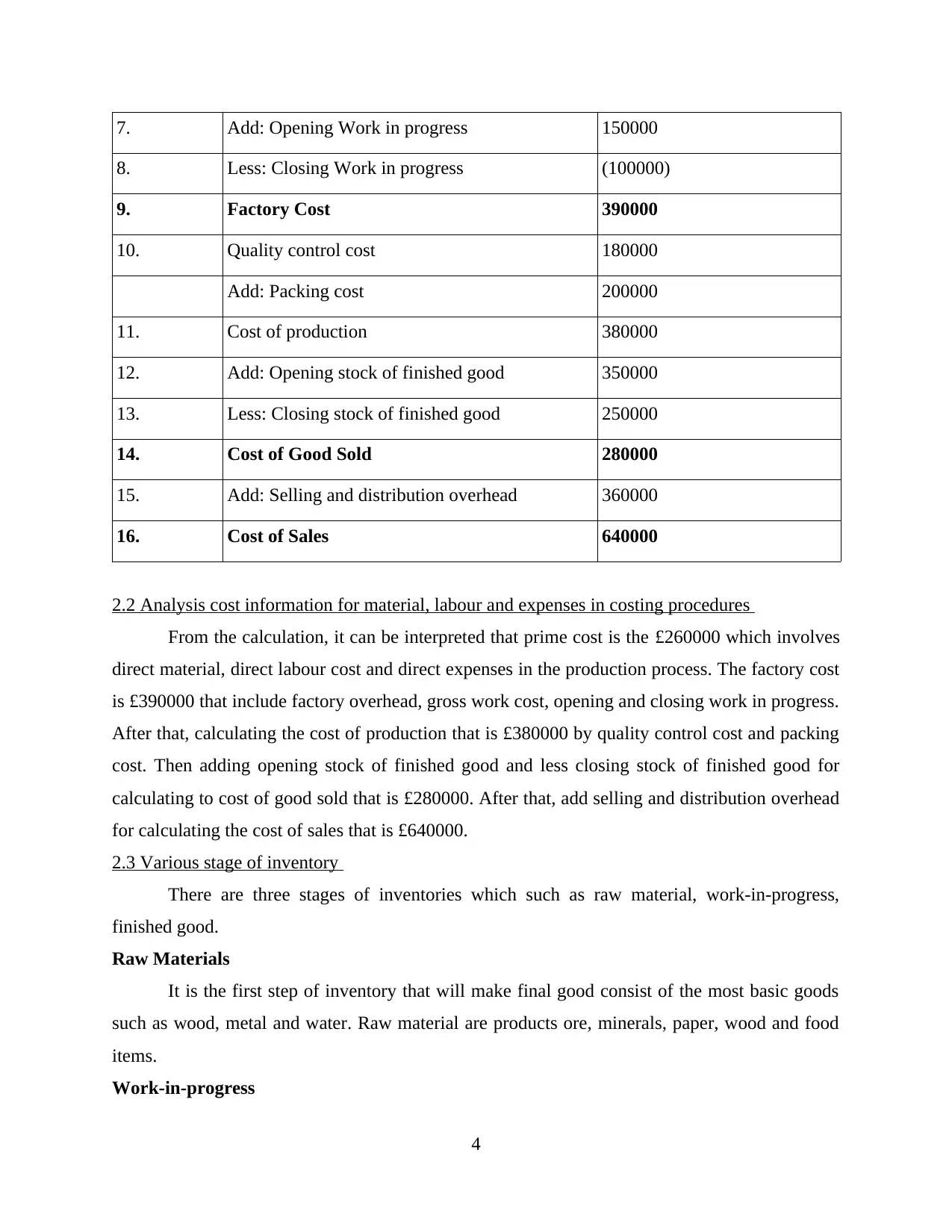
7. Add: Opening Work in progress 150000
8. Less: Closing Work in progress (100000)
9. Factory Cost 390000
10. Quality control cost 180000
Add: Packing cost 200000
11. Cost of production 380000
12. Add: Opening stock of finished good 350000
13. Less: Closing stock of finished good 250000
14. Cost of Good Sold 280000
15. Add: Selling and distribution overhead 360000
16. Cost of Sales 640000
2.2 Analysis cost information for material, labour and expenses in costing procedures
From the calculation, it can be interpreted that prime cost is the £260000 which involves
direct material, direct labour cost and direct expenses in the production process. The factory cost
is £390000 that include factory overhead, gross work cost, opening and closing work in progress.
After that, calculating the cost of production that is £380000 by quality control cost and packing
cost. Then adding opening stock of finished good and less closing stock of finished good for
calculating to cost of good sold that is £280000. After that, add selling and distribution overhead
for calculating the cost of sales that is £640000.
2.3 Various stage of inventory
There are three stages of inventories which such as raw material, work-in-progress,
finished good.
Raw Materials
It is the first step of inventory that will make final good consist of the most basic goods
such as wood, metal and water. Raw material are products ore, minerals, paper, wood and food
items.
Work-in-progress
4
8. Less: Closing Work in progress (100000)
9. Factory Cost 390000
10. Quality control cost 180000
Add: Packing cost 200000
11. Cost of production 380000
12. Add: Opening stock of finished good 350000
13. Less: Closing stock of finished good 250000
14. Cost of Good Sold 280000
15. Add: Selling and distribution overhead 360000
16. Cost of Sales 640000
2.2 Analysis cost information for material, labour and expenses in costing procedures
From the calculation, it can be interpreted that prime cost is the £260000 which involves
direct material, direct labour cost and direct expenses in the production process. The factory cost
is £390000 that include factory overhead, gross work cost, opening and closing work in progress.
After that, calculating the cost of production that is £380000 by quality control cost and packing
cost. Then adding opening stock of finished good and less closing stock of finished good for
calculating to cost of good sold that is £280000. After that, add selling and distribution overhead
for calculating the cost of sales that is £640000.
2.3 Various stage of inventory
There are three stages of inventories which such as raw material, work-in-progress,
finished good.
Raw Materials
It is the first step of inventory that will make final good consist of the most basic goods
such as wood, metal and water. Raw material are products ore, minerals, paper, wood and food
items.
Work-in-progress
4
⊘ This is a preview!⊘
Do you want full access?
Subscribe today to unlock all pages.

Trusted by 1+ million students worldwide
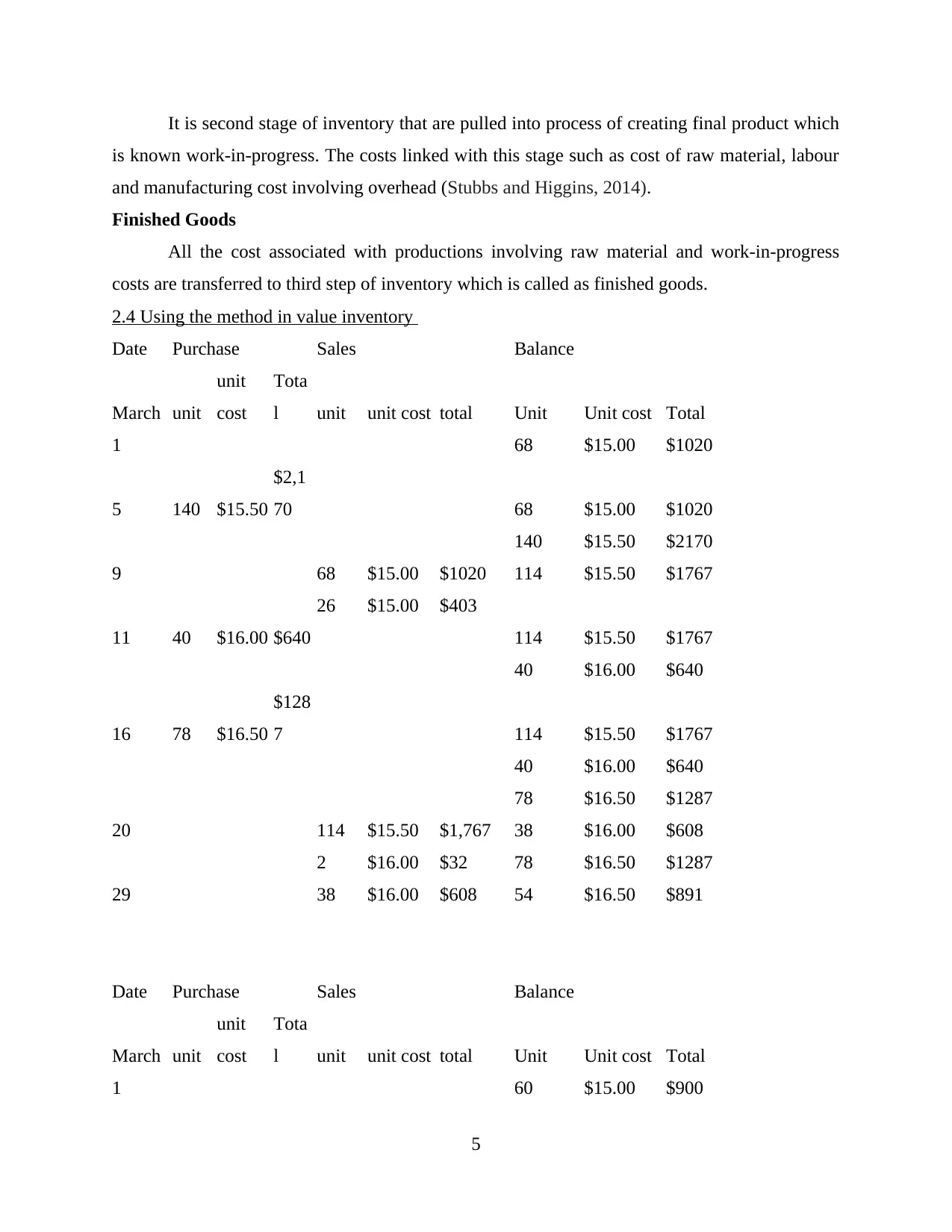
It is second stage of inventory that are pulled into process of creating final product which
is known work-in-progress. The costs linked with this stage such as cost of raw material, labour
and manufacturing cost involving overhead (Stubbs and Higgins, 2014).
Finished Goods
All the cost associated with productions involving raw material and work-in-progress
costs are transferred to third step of inventory which is called as finished goods.
2.4 Using the method in value inventory
Date Purchase Sales Balance
March unit
unit
cost
Tota
l unit unit cost total Unit Unit cost Total
1 68 $15.00 $1020
5 140 $15.50
$2,1
70 68 $15.00 $1020
140 $15.50 $2170
9 68 $15.00 $1020 114 $15.50 $1767
26 $15.00 $403
11 40 $16.00 $640 114 $15.50 $1767
40 $16.00 $640
16 78 $16.50
$128
7 114 $15.50 $1767
40 $16.00 $640
78 $16.50 $1287
20 114 $15.50 $1,767 38 $16.00 $608
2 $16.00 $32 78 $16.50 $1287
29 38 $16.00 $608 54 $16.50 $891
Date Purchase Sales Balance
March unit
unit
cost
Tota
l unit unit cost total Unit Unit cost Total
1 60 $15.00 $900
5
is known work-in-progress. The costs linked with this stage such as cost of raw material, labour
and manufacturing cost involving overhead (Stubbs and Higgins, 2014).
Finished Goods
All the cost associated with productions involving raw material and work-in-progress
costs are transferred to third step of inventory which is called as finished goods.
2.4 Using the method in value inventory
Date Purchase Sales Balance
March unit
unit
cost
Tota
l unit unit cost total Unit Unit cost Total
1 68 $15.00 $1020
5 140 $15.50
$2,1
70 68 $15.00 $1020
140 $15.50 $2170
9 68 $15.00 $1020 114 $15.50 $1767
26 $15.00 $403
11 40 $16.00 $640 114 $15.50 $1767
40 $16.00 $640
16 78 $16.50
$128
7 114 $15.50 $1767
40 $16.00 $640
78 $16.50 $1287
20 114 $15.50 $1,767 38 $16.00 $608
2 $16.00 $32 78 $16.50 $1287
29 38 $16.00 $608 54 $16.50 $891
Date Purchase Sales Balance
March unit
unit
cost
Tota
l unit unit cost total Unit Unit cost Total
1 60 $15.00 $900
5
Paraphrase This Document
Need a fresh take? Get an instant paraphrase of this document with our AI Paraphraser
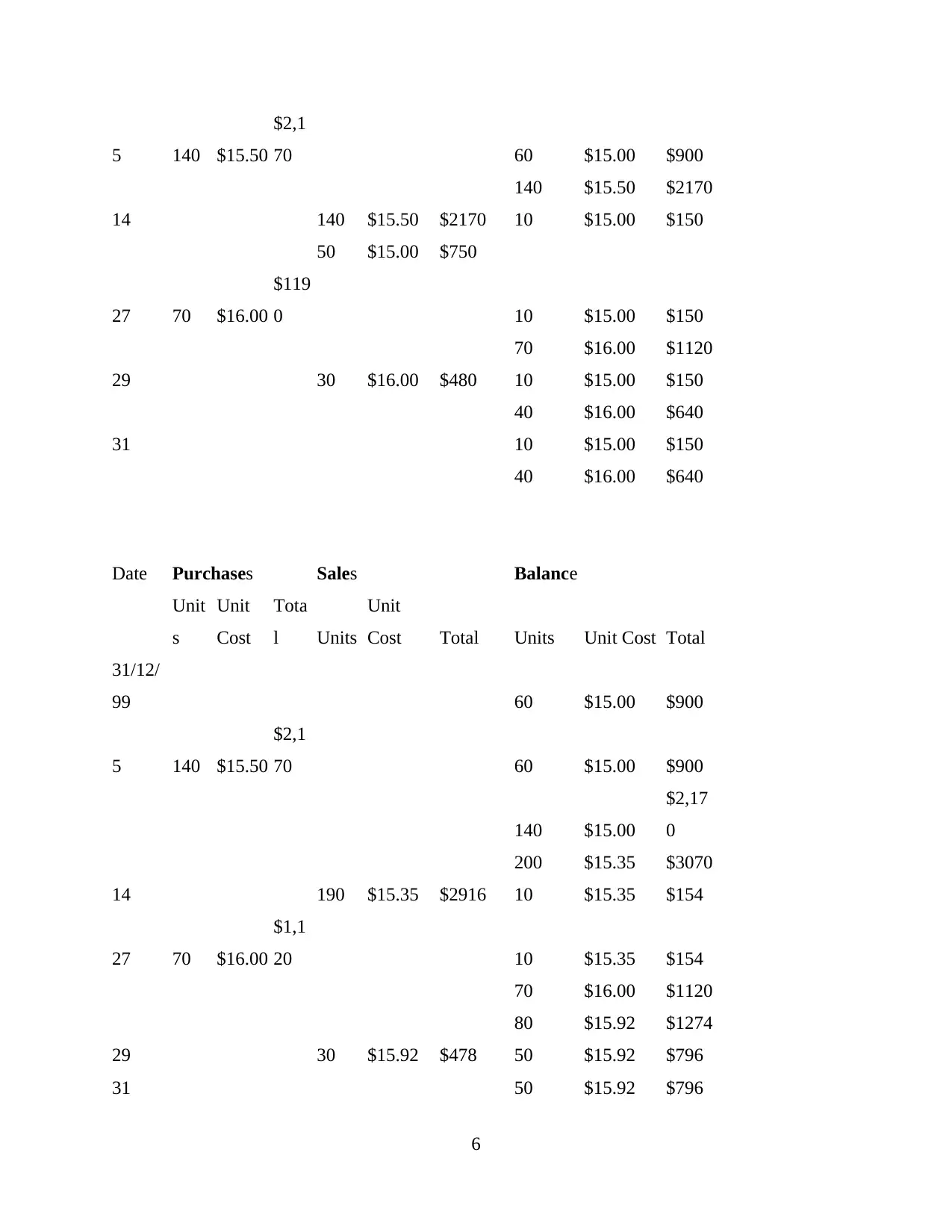
5 140 $15.50
$2,1
70 60 $15.00 $900
140 $15.50 $2170
14 140 $15.50 $2170 10 $15.00 $150
50 $15.00 $750
27 70 $16.00
$119
0 10 $15.00 $150
70 $16.00 $1120
29 30 $16.00 $480 10 $15.00 $150
40 $16.00 $640
31 10 $15.00 $150
40 $16.00 $640
Date Purchases Sales Balance
Unit
s
Unit
Cost
Tota
l Units
Unit
Cost Total Units Unit Cost Total
31/12/
99 60 $15.00 $900
5 140 $15.50
$2,1
70 60 $15.00 $900
140 $15.00
$2,17
0
200 $15.35 $3070
14 190 $15.35 $2916 10 $15.35 $154
27 70 $16.00
$1,1
20 10 $15.35 $154
70 $16.00 $1120
80 $15.92 $1274
29 30 $15.92 $478 50 $15.92 $796
31 50 $15.92 $796
6
$2,1
70 60 $15.00 $900
140 $15.50 $2170
14 140 $15.50 $2170 10 $15.00 $150
50 $15.00 $750
27 70 $16.00
$119
0 10 $15.00 $150
70 $16.00 $1120
29 30 $16.00 $480 10 $15.00 $150
40 $16.00 $640
31 10 $15.00 $150
40 $16.00 $640
Date Purchases Sales Balance
Unit
s
Unit
Cost
Tota
l Units
Unit
Cost Total Units Unit Cost Total
31/12/
99 60 $15.00 $900
5 140 $15.50
$2,1
70 60 $15.00 $900
140 $15.00
$2,17
0
200 $15.35 $3070
14 190 $15.35 $2916 10 $15.35 $154
27 70 $16.00
$1,1
20 10 $15.35 $154
70 $16.00 $1120
80 $15.92 $1274
29 30 $15.92 $478 50 $15.92 $796
31 50 $15.92 $796
6
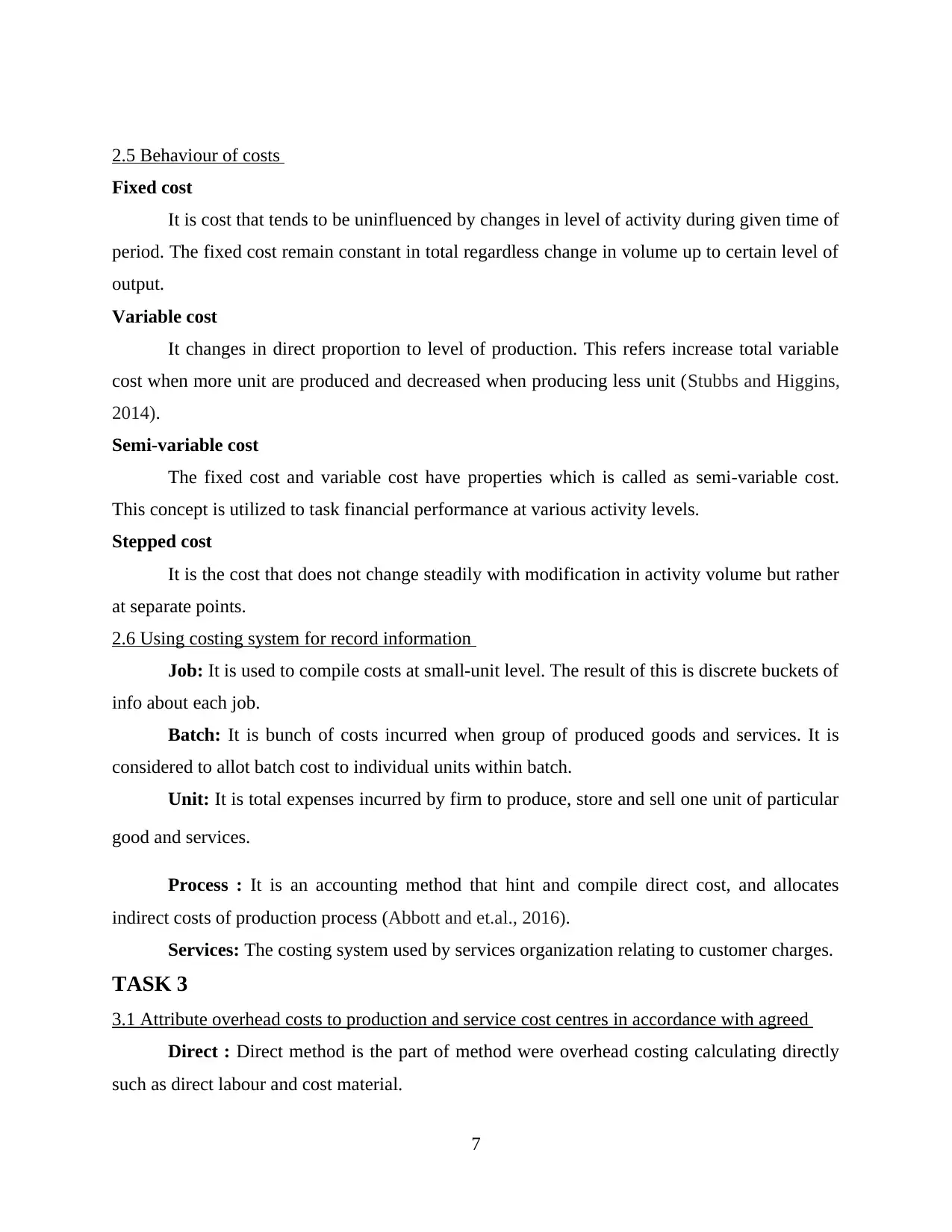
2.5 Behaviour of costs
Fixed cost
It is cost that tends to be uninfluenced by changes in level of activity during given time of
period. The fixed cost remain constant in total regardless change in volume up to certain level of
output.
Variable cost
It changes in direct proportion to level of production. This refers increase total variable
cost when more unit are produced and decreased when producing less unit (Stubbs and Higgins,
2014).
Semi-variable cost
The fixed cost and variable cost have properties which is called as semi-variable cost.
This concept is utilized to task financial performance at various activity levels.
Stepped cost
It is the cost that does not change steadily with modification in activity volume but rather
at separate points.
2.6 Using costing system for record information
Job: It is used to compile costs at small-unit level. The result of this is discrete buckets of
info about each job.
Batch: It is bunch of costs incurred when group of produced goods and services. It is
considered to allot batch cost to individual units within batch.
Unit: It is total expenses incurred by firm to produce, store and sell one unit of particular
good and services.
Process : It is an accounting method that hint and compile direct cost, and allocates
indirect costs of production process (Abbott and et.al., 2016).
Services: The costing system used by services organization relating to customer charges.
TASK 3
3.1 Attribute overhead costs to production and service cost centres in accordance with agreed
Direct : Direct method is the part of method were overhead costing calculating directly
such as direct labour and cost material.
7
Fixed cost
It is cost that tends to be uninfluenced by changes in level of activity during given time of
period. The fixed cost remain constant in total regardless change in volume up to certain level of
output.
Variable cost
It changes in direct proportion to level of production. This refers increase total variable
cost when more unit are produced and decreased when producing less unit (Stubbs and Higgins,
2014).
Semi-variable cost
The fixed cost and variable cost have properties which is called as semi-variable cost.
This concept is utilized to task financial performance at various activity levels.
Stepped cost
It is the cost that does not change steadily with modification in activity volume but rather
at separate points.
2.6 Using costing system for record information
Job: It is used to compile costs at small-unit level. The result of this is discrete buckets of
info about each job.
Batch: It is bunch of costs incurred when group of produced goods and services. It is
considered to allot batch cost to individual units within batch.
Unit: It is total expenses incurred by firm to produce, store and sell one unit of particular
good and services.
Process : It is an accounting method that hint and compile direct cost, and allocates
indirect costs of production process (Abbott and et.al., 2016).
Services: The costing system used by services organization relating to customer charges.
TASK 3
3.1 Attribute overhead costs to production and service cost centres in accordance with agreed
Direct : Direct method is the part of method were overhead costing calculating directly
such as direct labour and cost material.
7
⊘ This is a preview!⊘
Do you want full access?
Subscribe today to unlock all pages.

Trusted by 1+ million students worldwide
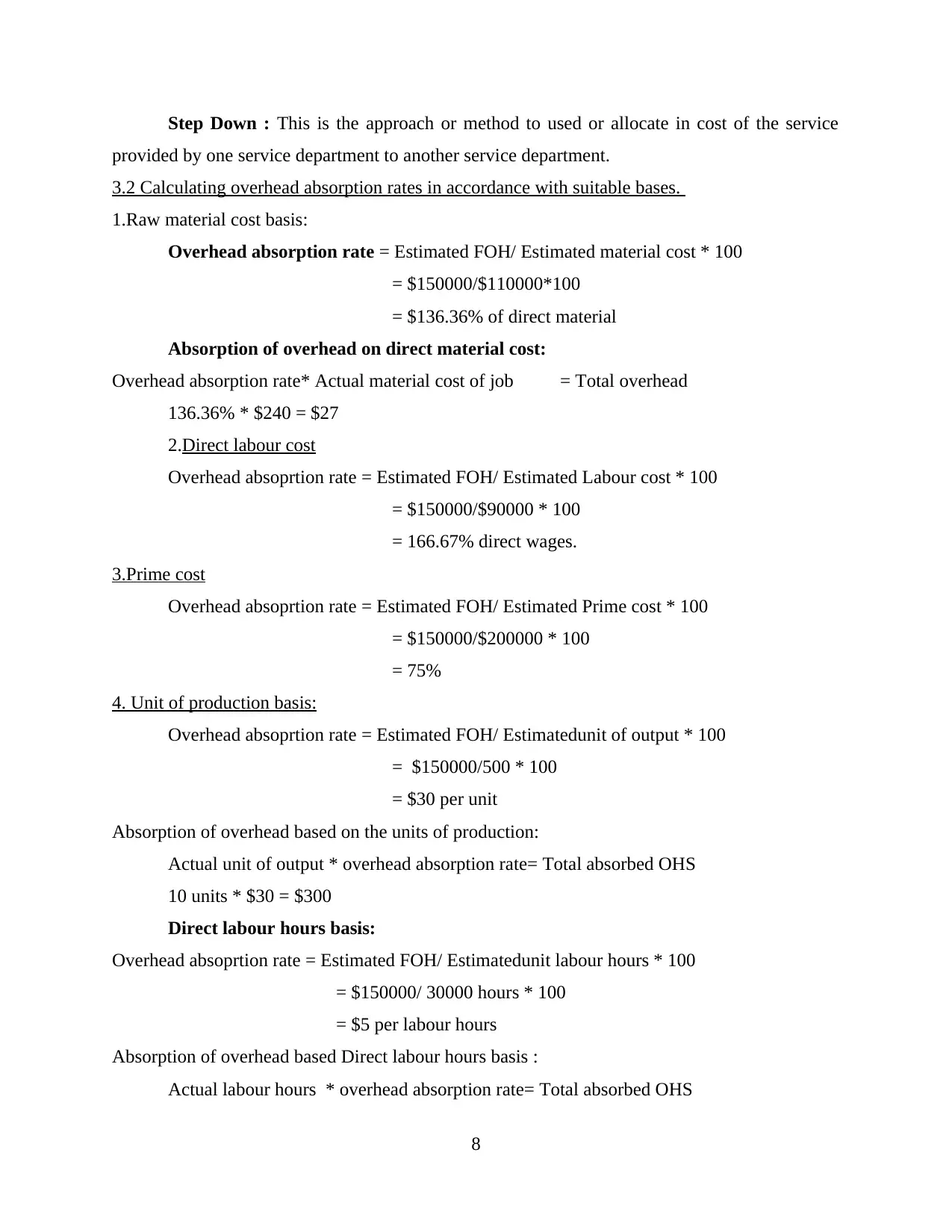
Step Down : This is the approach or method to used or allocate in cost of the service
provided by one service department to another service department.
3.2 Calculating overhead absorption rates in accordance with suitable bases.
1.Raw material cost basis:
Overhead absorption rate = Estimated FOH/ Estimated material cost * 100
= $150000/$110000*100
= $136.36% of direct material
Absorption of overhead on direct material cost:
Overhead absorption rate* Actual material cost of job = Total overhead
136.36% * $240 = $27
2.Direct labour cost
Overhead absoprtion rate = Estimated FOH/ Estimated Labour cost * 100
= $150000/$90000 * 100
= 166.67% direct wages.
3.Prime cost
Overhead absoprtion rate = Estimated FOH/ Estimated Prime cost * 100
= $150000/$200000 * 100
= 75%
4. Unit of production basis:
Overhead absoprtion rate = Estimated FOH/ Estimatedunit of output * 100
= $150000/500 * 100
= $30 per unit
Absorption of overhead based on the units of production:
Actual unit of output * overhead absorption rate= Total absorbed OHS
10 units * $30 = $300
Direct labour hours basis:
Overhead absoprtion rate = Estimated FOH/ Estimatedunit labour hours * 100
= $150000/ 30000 hours * 100
= $5 per labour hours
Absorption of overhead based Direct labour hours basis :
Actual labour hours * overhead absorption rate= Total absorbed OHS
8
provided by one service department to another service department.
3.2 Calculating overhead absorption rates in accordance with suitable bases.
1.Raw material cost basis:
Overhead absorption rate = Estimated FOH/ Estimated material cost * 100
= $150000/$110000*100
= $136.36% of direct material
Absorption of overhead on direct material cost:
Overhead absorption rate* Actual material cost of job = Total overhead
136.36% * $240 = $27
2.Direct labour cost
Overhead absoprtion rate = Estimated FOH/ Estimated Labour cost * 100
= $150000/$90000 * 100
= 166.67% direct wages.
3.Prime cost
Overhead absoprtion rate = Estimated FOH/ Estimated Prime cost * 100
= $150000/$200000 * 100
= 75%
4. Unit of production basis:
Overhead absoprtion rate = Estimated FOH/ Estimatedunit of output * 100
= $150000/500 * 100
= $30 per unit
Absorption of overhead based on the units of production:
Actual unit of output * overhead absorption rate= Total absorbed OHS
10 units * $30 = $300
Direct labour hours basis:
Overhead absoprtion rate = Estimated FOH/ Estimatedunit labour hours * 100
= $150000/ 30000 hours * 100
= $5 per labour hours
Absorption of overhead based Direct labour hours basis :
Actual labour hours * overhead absorption rate= Total absorbed OHS
8
Paraphrase This Document
Need a fresh take? Get an instant paraphrase of this document with our AI Paraphraser
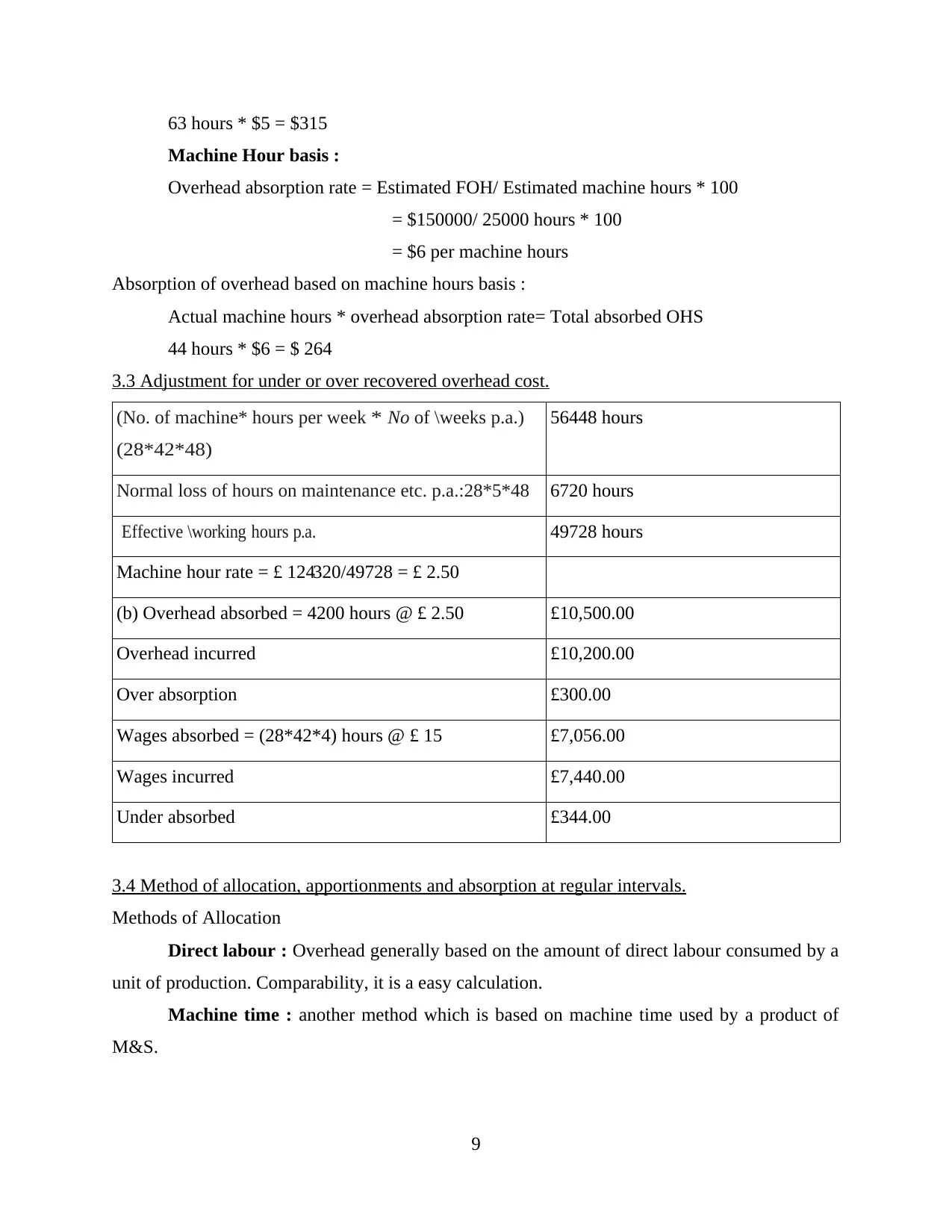
63 hours * $5 = $315
Machine Hour basis :
Overhead absorption rate = Estimated FOH/ Estimated machine hours * 100
= $150000/ 25000 hours * 100
= $6 per machine hours
Absorption of overhead based on machine hours basis :
Actual machine hours * overhead absorption rate= Total absorbed OHS
44 hours * $6 = $ 264
3.3 Adjustment for under or over recovered overhead cost.
(No. of machine* hours per week * No of \weeks p.a.)
(28*42*48)
56448 hours
Normal loss of hours on maintenance etc. p.a.:28*5*48 6720 hours
Effective \working hours p.a. 49728 hours
Machine hour rate = £ 124320/49728 = £ 2.50
(b) Overhead absorbed = 4200 hours @ £ 2.50 £10,500.00
Overhead incurred £10,200.00
Over absorption £300.00
Wages absorbed = (28*42*4) hours @ £ 15 £7,056.00
Wages incurred £7,440.00
Under absorbed £344.00
3.4 Method of allocation, apportionments and absorption at regular intervals.
Methods of Allocation
Direct labour : Overhead generally based on the amount of direct labour consumed by a
unit of production. Comparability, it is a easy calculation.
Machine time : another method which is based on machine time used by a product of
M&S.
9
Machine Hour basis :
Overhead absorption rate = Estimated FOH/ Estimated machine hours * 100
= $150000/ 25000 hours * 100
= $6 per machine hours
Absorption of overhead based on machine hours basis :
Actual machine hours * overhead absorption rate= Total absorbed OHS
44 hours * $6 = $ 264
3.3 Adjustment for under or over recovered overhead cost.
(No. of machine* hours per week * No of \weeks p.a.)
(28*42*48)
56448 hours
Normal loss of hours on maintenance etc. p.a.:28*5*48 6720 hours
Effective \working hours p.a. 49728 hours
Machine hour rate = £ 124320/49728 = £ 2.50
(b) Overhead absorbed = 4200 hours @ £ 2.50 £10,500.00
Overhead incurred £10,200.00
Over absorption £300.00
Wages absorbed = (28*42*4) hours @ £ 15 £7,056.00
Wages incurred £7,440.00
Under absorbed £344.00
3.4 Method of allocation, apportionments and absorption at regular intervals.
Methods of Allocation
Direct labour : Overhead generally based on the amount of direct labour consumed by a
unit of production. Comparability, it is a easy calculation.
Machine time : another method which is based on machine time used by a product of
M&S.
9
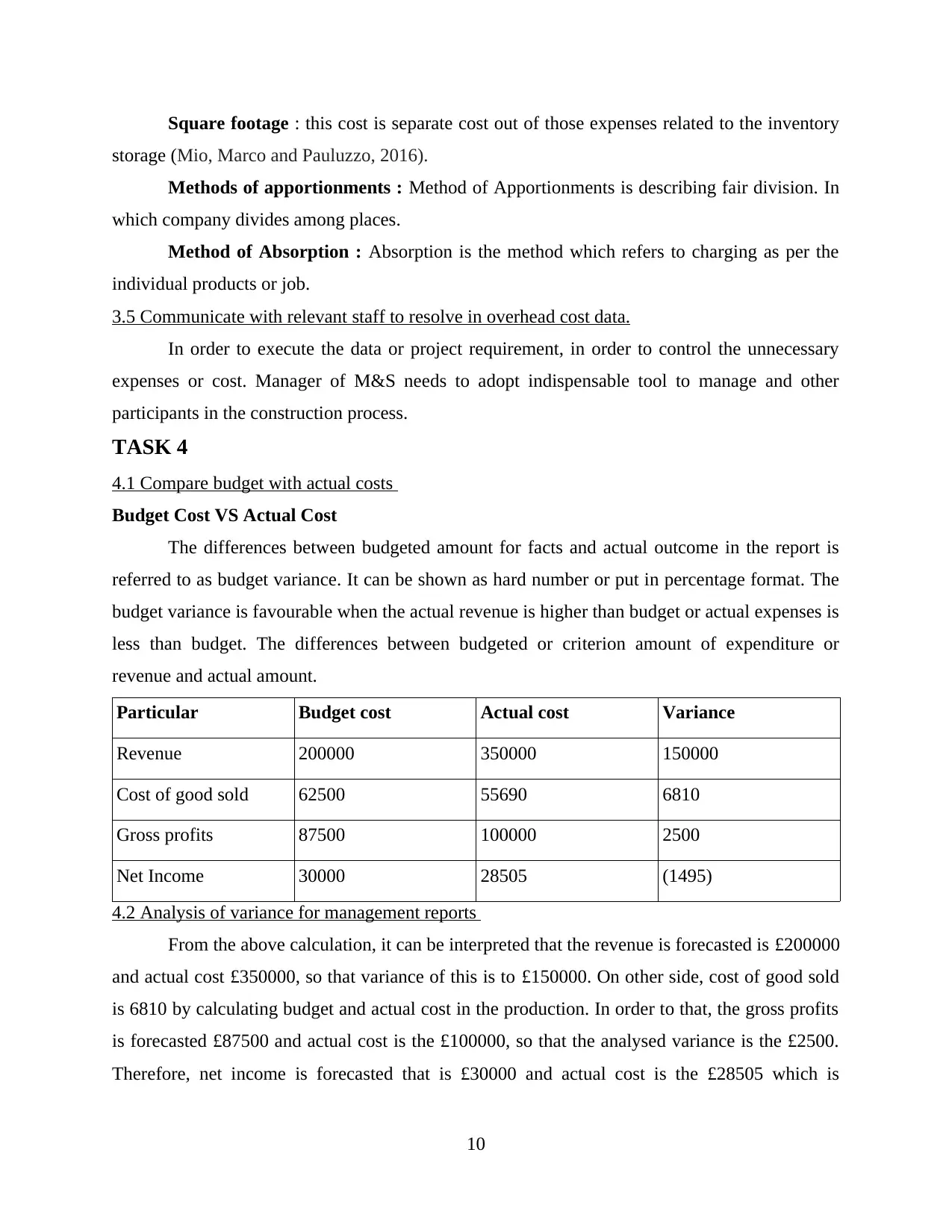
Square footage : this cost is separate cost out of those expenses related to the inventory
storage (Mio, Marco and Pauluzzo, 2016).
Methods of apportionments : Method of Apportionments is describing fair division. In
which company divides among places.
Method of Absorption : Absorption is the method which refers to charging as per the
individual products or job.
3.5 Communicate with relevant staff to resolve in overhead cost data.
In order to execute the data or project requirement, in order to control the unnecessary
expenses or cost. Manager of M&S needs to adopt indispensable tool to manage and other
participants in the construction process.
TASK 4
4.1 Compare budget with actual costs
Budget Cost VS Actual Cost
The differences between budgeted amount for facts and actual outcome in the report is
referred to as budget variance. It can be shown as hard number or put in percentage format. The
budget variance is favourable when the actual revenue is higher than budget or actual expenses is
less than budget. The differences between budgeted or criterion amount of expenditure or
revenue and actual amount.
Particular Budget cost Actual cost Variance
Revenue 200000 350000 150000
Cost of good sold 62500 55690 6810
Gross profits 87500 100000 2500
Net Income 30000 28505 (1495)
4.2 Analysis of variance for management reports
From the above calculation, it can be interpreted that the revenue is forecasted is £200000
and actual cost £350000, so that variance of this is to £150000. On other side, cost of good sold
is 6810 by calculating budget and actual cost in the production. In order to that, the gross profits
is forecasted £87500 and actual cost is the £100000, so that the analysed variance is the £2500.
Therefore, net income is forecasted that is £30000 and actual cost is the £28505 which is
10
storage (Mio, Marco and Pauluzzo, 2016).
Methods of apportionments : Method of Apportionments is describing fair division. In
which company divides among places.
Method of Absorption : Absorption is the method which refers to charging as per the
individual products or job.
3.5 Communicate with relevant staff to resolve in overhead cost data.
In order to execute the data or project requirement, in order to control the unnecessary
expenses or cost. Manager of M&S needs to adopt indispensable tool to manage and other
participants in the construction process.
TASK 4
4.1 Compare budget with actual costs
Budget Cost VS Actual Cost
The differences between budgeted amount for facts and actual outcome in the report is
referred to as budget variance. It can be shown as hard number or put in percentage format. The
budget variance is favourable when the actual revenue is higher than budget or actual expenses is
less than budget. The differences between budgeted or criterion amount of expenditure or
revenue and actual amount.
Particular Budget cost Actual cost Variance
Revenue 200000 350000 150000
Cost of good sold 62500 55690 6810
Gross profits 87500 100000 2500
Net Income 30000 28505 (1495)
4.2 Analysis of variance for management reports
From the above calculation, it can be interpreted that the revenue is forecasted is £200000
and actual cost £350000, so that variance of this is to £150000. On other side, cost of good sold
is 6810 by calculating budget and actual cost in the production. In order to that, the gross profits
is forecasted £87500 and actual cost is the £100000, so that the analysed variance is the £2500.
Therefore, net income is forecasted that is £30000 and actual cost is the £28505 which is
10
⊘ This is a preview!⊘
Do you want full access?
Subscribe today to unlock all pages.

Trusted by 1+ million students worldwide
1 out of 18
Related Documents
Your All-in-One AI-Powered Toolkit for Academic Success.
+13062052269
info@desklib.com
Available 24*7 on WhatsApp / Email
![[object Object]](/_next/static/media/star-bottom.7253800d.svg)
Unlock your academic potential
Copyright © 2020–2025 A2Z Services. All Rights Reserved. Developed and managed by ZUCOL.





